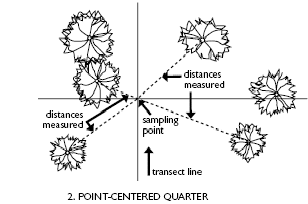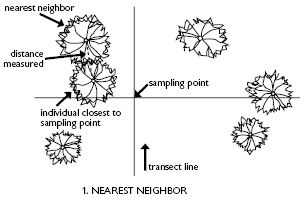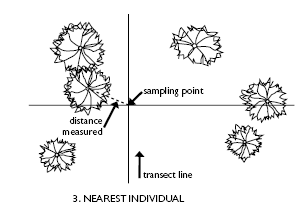|
Measuring density without plots
Is a Quadrat Needed?
Counting the number of plants in a quadrat can be very time
consuming. Therefore, alternative methods have been developed that are
based on the distance between plants or the distance from a specific point and a
plant.
One unavoidable truth when measuring vegetation density is that plant
Density and Distance between Plants is inextricably linked:
High Density = Plants that are Close Together
or
Low Plant Density =Plants that are Far
Apart
Techniques based on this premise are called plotless
or distance-based techniques.
The basic idea of these distance techniques is that density can be
calculated if the average space occupied by individual plants can be
determined. These techniques assume:
Distance techniques were generally developed in forests, but they can be applied
to grasslands and shrublands if:
-
Individual plants can be easily recognized (i.e., shrubland or bunchgrass
communities)
-
Space between plants is a measurable amount (i.e., relatively sparse comm.)
Plotless techniques can have several advantages over quadrat-based techniques:
-
Usually faster (especially in sparse communities).
-
Requires less equipment - just need a way to measure distance (e.g., meter stick,
tape measure, or laser range finder).
-
Does not require selection or adjustment in quadrat size.
Basic Distance Relationships
It is not surprising that the distances between plants or between a
selected point and plants in the area are related by basic principles of
geometry. Therefore, all distance based techniques are related by this
general equation:

D= Density
A = Area of interest (like meter squared)
d
= Distance measured in the field
The term "X" in these
equations varies depending on assumptions about distance between plants or
points to a plant. Each technique or method includes some twist on the value for
X.
Three Basic Plotless or Distance Methods
About 8 to 10
methods have been developed to estimate and calculate density based on
distances. However, we will outline just 3 methods here following Elzinga et
al. 1998 (pages 172-173). In the examples below, focus on what is
measured and become familiar with the equation of how distance is related to
density. 1)
Point-Centered Quarter

The distance from a
sample point to the nearest plant in each of four quarters or quadrants.
 Choose a
series of points in the sample area (at least 15). Choose a
series of points in the sample area (at least 15).
 Place a
“cross” or “plus” shaped guide/frame over the point. Place a
“cross” or “plus” shaped guide/frame over the point.
 Measure
the distance from the point to the nearest plant of interest in each of the
quadrants outlined by the cross-shaped guide. Measure
the distance from the point to the nearest plant of interest in each of the
quadrants outlined by the cross-shaped guide.
Estimate Density:

For example:
Distance of point to shrub
Quarter 1= 0.5 meters
Quarter 2 = 0.35 meters
Quarter 3 = 0.4 meter
Quarter 4 = 1.2 meters
The average distance to a plant (d)
= .61 meters
If we want to express density in number of plants/m2 then
1 m2/(.61)2 = 2.7 plants/m2
If you want to express density in number of plants per hectare in this examplethen:
There are 10,000 m2 in a ha so 10,000 m2/(.61)2
= 27,027 plants/ha
The technique
assumes that the area around plants is roughly circular and points are far enough
apart so that no plant is measured twice.
2) Nearest Neighbor

The distance from a selected plant to its nearest plant (neighbor) is measured.
 Choose a
referent plant - (usually the closest individual to a selected point.) Choose a
referent plant - (usually the closest individual to a selected point.)
 Identify the plant closest to the referent plant and measure the distance
between these two plants.
Identify the plant closest to the referent plant and measure the distance
between these two plants.
Estimate
density:

3)
Closest Individual

The distance from a
sample point to the closest individual is measured.
 Choose a
series of points in the sample area Choose a
series of points in the sample area
 Measure
the distance to the closest plant of interest Measure
the distance to the closest plant of interest
Estimate density:

Reference
Elzinga, C.L., D.W. Salzer and J.W. Willoughby. 1998.
Measuring and Monitoring Plant Populations. Technical Reference 1730-1.
Bureau of Land Management. Denver, Colorado. USDI, BLM |